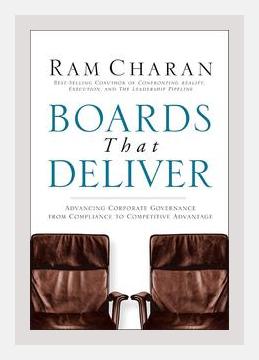Business Law and EthicsCorporate Governance
**Title:
Introduction
Ram Charan’s “Boards That Deliver” delves into the transformation of corporate governance from a compliance-focused framework to one that provides a competitive advantage. By examining the roles and behaviors that effective boards exhibit, Charan outlines actionable strategies to enhance board performance and corporate governance.
Chapter 1: The Changing Role of the Board
- Major Point: Boards must transition from being mere overseers to becoming strategic assets that provide valuable insights and guidance.
- Example: A board that actively participates in strategy sessions and provides critical feedback helps the company navigate complex business landscapes.
- Action: Organize regular strategy workshops where board members can contribute their expertise and align on long-term goals.
Chapter 2: Building a High-Performing Board
- Major Point: The composition of the board is crucial for its effectiveness.
- Example: Diverse boards bring different perspectives, which enhance decision-making and risk assessment. For instance, including members with digital expertise can help a company adapt to technological advancements.
- Action: Conduct a skills gap analysis of current board members and strategically recruit individuals with the needed expertise.
Chapter 3: Structuring Effective Board Meetings
- Major Point: Well-structured board meetings are essential for efficient governance.
- Example: Streamlining the agenda to focus on strategic issues rather than operational details enhances productive discussions. Charan suggests using consent agendas to quickly approve routine items.
- Action: Implement a consent agenda system and allocate more time for strategic discussions during board meetings.
Chapter 4: Enhancing Information Flow
- Major Point: Reliable and timely information is critical for board members to make informed decisions.
- Example: Charan cites a company where the CEO provides a comprehensive board packet a week in advance, enabling directors to come prepared with insights and questions.
- Action: Establish a protocol for the timely dissemination of pre-meeting materials, ensuring that all board members are well-prepared.
Chapter 5: Fostering Effective Board-Management Relations
- Major Point: A strong relationship between the board and the CEO is fundamental.
- Example: Regular, informal interactions between board members and the CEO can build trust and improve communication. Charan describes how periodic dinners or retreats foster better relationships.
- Action: Schedule quarterly informal interactions between the board and the management team to build rapport and alignment.
Chapter 6: The Role of Board Committees
- Major Point: Effective board committees contribute significantly to overall governance.
- Example: Audit, Compensation, and Nominating committees play specialized roles that ensure thorough oversight and strategic alignment. Charan discusses how a well-functioning Audit Committee can mitigate financial risks.
- Action: Ensure that each committee has a clear mandate, defined responsibilities, and is composed of members with the relevant expertise.
Chapter 7: Board Dynamics and Culture
- Major Point: The culture within the boardroom can make or break the effectiveness of governance.
- Example: Open, constructive, and respectful debate leads to better decisions. Charan gives the example of a board that embraces diverse opinions to arrive at a consensus.
- Action: Foster an environment where board members feel comfortable expressing dissenting opinions without fear of reprisal.
Chapter 8: Evaluating Board Performance
- Major Point: Regular and systematic evaluation of the board’s performance is critical for continuous improvement.
- Example: Implementing a peer review process where directors evaluate each other can provide valuable feedback. Charan describes a board that uses third-party consultants for unbiased assessments.
- Action: Develop a formalized board evaluation process, including self-assessments and external reviews, to identify areas for improvement.
Chapter 9: Role in Risk Management
- Major Point: Boards must provide robust oversight of the company’s risk management processes.
- Example: Charan highlights a multinational corporation where the board conducted scenario planning exercises to anticipate potential risks.
- Action: Integrate risk management into the board’s regular agenda, including periodic scenario planning sessions to identify and prepare for potential risks.
Chapter 10: The Strategic Role of the Board
- Major Point: Boards should be deeply involved in shaping and overseeing company strategy.
- Example: A proactive board that reviews and challenges strategic initiatives can drive better long-term performance. Charan describes a board that regularly revisits and adjusts its strategic plans.
- Action: Hold annual strategy retreats where the board and management review and refine the company’s strategic plan together.
Chapter 11: Succession Planning
- Major Point: Ensuring a smooth transition for key leadership roles is a critical board responsibility.
- Example: Effective succession planning involves not just identifying potential candidates but also grooming them for leadership. Charan describes a company that uses rotational assignments to develop future leaders.
- Action: Develop a structured succession planning process that includes identifying internal candidates, providing them with development opportunities, and regularly reviewing progress.
Chapter 12: The Future of Corporate Governance
- Major Point: Corporate governance is evolving, and boards must stay ahead of trends to remain effective.
- Example: Charan foresaw increased regulatory scrutiny post-Enron and advised boards to adopt higher governance standards proactively.
- Action: Stay informed about emerging governance trends and regulatory changes. Consider periodic governance audits to ensure the board’s practices are current and robust.
Conclusion
“Boards That Deliver” by Ram Charan offers a roadmap for transforming boards from compliance-focused bodies into strategic assets that contribute significantly to a company’s success. By emphasizing effective communication, strategic involvement, and a culture of continuous improvement, Charan provides actionable insights that can help boards deliver greater value.
References
Charan, Ram. Boards That Deliver: Advancing Corporate Governance from Compliance to Competitive Advantage. Jossey-Bass, 2005.
